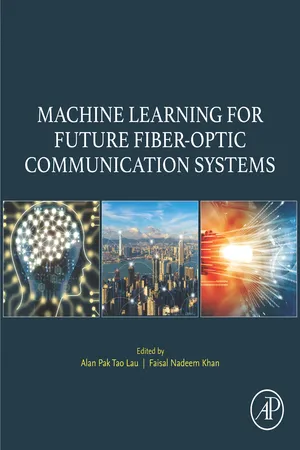
Machine Learning for Future Fiber-Optic Communication Systems
- 402 pages
- English
- ePUB (mobile friendly)
- Available on iOS & Android
Machine Learning for Future Fiber-Optic Communication Systems
About This Book
Machine Learning for Future Fiber-Optic Communication Systems provides a comprehensive and in-depth treatment of machine learning concepts and techniques applied to key areas within optical communications and networking, reflecting the state-of-the-art research and industrial practices. The book gives knowledge and insights into the role machine learning-based mechanisms will soon play in the future realization of intelligent optical network infrastructures that can manage and monitor themselves, diagnose and resolve problems, and provide intelligent and efficient services to the end users.
With up-to-date coverage and extensive treatment of various important topics related to machine learning for fiber-optic communication systems, this book is an invaluable reference for photonics researchers and engineers. It is also a very suitable text for graduate students interested in ML-based signal processing and networking.
- Discusses the reasons behind the recent popularity of machine learning (ML) concepts in modern optical communication networks and the why/where/how ML can play a unique role
- Presents fundamental ML techniques like artificial neural networks (ANNs), support vector machines (SVMs), K-means clustering, expectation-maximization (EM) algorithm, principal component analysis (PCA), independent component analysis (ICA), reinforcement learning, and more
- Covers advanced deep learning (DL) methods such as deep neural networks (DNNs), convolutional neural networks (CNNs), recurrent neural networks (RNNs), and generative adversarial networks (GANs)
- Individual chapters focus on ML applications in key areas of optical communications and networking
Frequently asked questions
Information
Table of contents
- Cover image
- Title page
- Table of Contents
- Copyright
- Dedication
- Contributors
- Preface
- Acknowledgments
- Chapter One: Introduction to machine learning techniques: An optical communication's perspective
- Chapter Two: Machine learning for long-haul optical systems
- Chapter Three: Machine learning for short reach optical fiber systems
- Chapter Four: Machine learning techniques for passive optical networks
- Chapter Five: End-to-end learning for fiber-optic communication systems
- Chapter Six: Deep learning techniques for optical monitoring
- Chapter Seven: Machine Learning methods for Quality-of-Transmission estimation
- Chapter Eight: Machine Learning for optical spectrum analysis
- Chapter Nine: Machine learning and data science for low-margin optical networks
- Chapter Ten: Machine learning for network security management, attacks, and intrusions detection
- Chapter Eleven: Machine learning for design and optimization of photonic devices
- Index